RADIO MICROWAVE AND OPTICAL CIRCUITS
Introduction:
Radio, Microwave and Opto-electronic circuits share similar aims; i.e. the processing of electromagnetic waves. Differences arise because of the changes in wavelength, 3 metres to 0.3 microns, and the way that these signals interact with lumped and distributed components.
Radio, Microwave and Opto-electronic circuits share similar aims; i.e. the processing of electromagnetic waves. Differences arise because of the changes in wavelength, 3 metres to 0.3 microns, and the way that these signals interact with lumped and distributed components.
This web page describes the work on Radio, Microwave and Optical Circuits at the Department of Electronics, University of York. It is shown that new electronic, opto-electronic and optical developments occur when radio techniques are applied to optics and vice versa. The following list describes the project areas under investigation.
This web page is all in one document. It can therefore be seen either by: scrolling down the page or by highlighting titles in the Index.
RF/Microwave Low Noise Oscillators
Liang Zhou, Yiming You, Marc Salin, C. Broomfield, J K A Everard
Theories have been developed which show how minimum sideband noise can be obtained in oscillators. It is shown that there are a number of optimum coupling coefficients between the resonator and amplifier as illustrated in the figure below. Typically the optimum noise performance occurs when QL/Q0 is 1/2 or 2/3 dependent on the definition of power within the oscillator. In General QL/Q0 = 1/2 is optimum. Low noise oscillators operating from 1 MHz to 10 GHz have been built which use Inductor Capacitor (LC), crystal, Surface Acoustic Wave (SAW), Dielectric, Helical and Transmission Line Resonators. These oscillators demonstrate noise performance usually within 1 dB of the predicted minimum. MMIC low noise oscillators have been designed and fabricated. Tunable low noise oscillators (both hybrid and MMIC) have been built and are under further investigation. Non linear modelling techniques, using Volterra Series, have been developed which accurately predict the output power and the operating frequency. Ultra-low noise reference standards for operation up to 20 GHz are being developed using sapphire dielectric resonators. Present performance at 7.5 GHz exceeds -143dBc/Hz @ 10 kHz offset. Improvements of around 35dB are currently under investigation. New techniques have just been developed (Sept. 2000 see publications, patent applications and book below) which suppress the flicker noise by 20dB down to the thermal limits for offsets above 10kHz. The phase noise results are now within 1/2 dB of the theoretical minimum noise performance set by thermal noise. This is achieved by using feedforward amplifiers as the oscillator sustaining stage and incorporating the limiting elsewhere.
Theories have been developed which show how minimum sideband noise can be obtained in oscillators. It is shown that there are a number of optimum coupling coefficients between the resonator and amplifier as illustrated in the figure below. Typically the optimum noise performance occurs when QL/Q0 is 1/2 or 2/3 dependent on the definition of power within the oscillator. In General QL/Q0 = 1/2 is optimum. Low noise oscillators operating from 1 MHz to 10 GHz have been built which use Inductor Capacitor (LC), crystal, Surface Acoustic Wave (SAW), Dielectric, Helical and Transmission Line Resonators. These oscillators demonstrate noise performance usually within 1 dB of the predicted minimum. MMIC low noise oscillators have been designed and fabricated. Tunable low noise oscillators (both hybrid and MMIC) have been built and are under further investigation. Non linear modelling techniques, using Volterra Series, have been developed which accurately predict the output power and the operating frequency. Ultra-low noise reference standards for operation up to 20 GHz are being developed using sapphire dielectric resonators. Present performance at 7.5 GHz exceeds -143dBc/Hz @ 10 kHz offset. Improvements of around 35dB are currently under investigation. New techniques have just been developed (Sept. 2000 see publications, patent applications and book below) which suppress the flicker noise by 20dB down to the thermal limits for offsets above 10kHz. The phase noise results are now within 1/2 dB of the theoretical minimum noise performance set by thermal noise. This is achieved by using feedforward amplifiers as the oscillator sustaining stage and incorporating the limiting elsewhere.
Supported by EPSRC
|
Flicker Noise Measurement and Reduction
J K A Everard, P Dallas
Flicker noise causes considerable degradation to the performance of oscillators and dividers which use GaAs. A system for measuring the low frequency Flicker noise on the gate and drain of a GaAs FET and the AM and PM components that these Flicker noises transpose onto a carrier has been developed as shown below. This system has been used to measure the cross correlation between the low frequency and the demodulated high frequency noises by measuring all the components simultaneously on a digitizing oscilloscope. These measurements can be used to determine the Flicker noise sources in GaAs FETs and the correlation between them. Flicker noise reduction techniques in GaAs FET oscillators are being investigated. Transposed Gain Oscillators offer -143 dBc/Hz @ 10 kHz offset at 7.5 GHz. New techniques have just been developed (Sept. 2000 see publications, patent applications and book below) which suppress the flicker noise by 20dB down to the thermal limits for offsets above 10kHz. The phase noise results are now within 1/2 dB of the theoretical minimum noise performance set by thermal noise. This is achieved by using feedforward amplifiers as the oscillator sustaining stage and incorporating the limiting elsewhere. Low frequency feedback for flicker noise suppression is now being re-investigated and optimised.
Flicker noise causes considerable degradation to the performance of oscillators and dividers which use GaAs. A system for measuring the low frequency Flicker noise on the gate and drain of a GaAs FET and the AM and PM components that these Flicker noises transpose onto a carrier has been developed as shown below. This system has been used to measure the cross correlation between the low frequency and the demodulated high frequency noises by measuring all the components simultaneously on a digitizing oscilloscope. These measurements can be used to determine the Flicker noise sources in GaAs FETs and the correlation between them. Flicker noise reduction techniques in GaAs FET oscillators are being investigated. Transposed Gain Oscillators offer -143 dBc/Hz @ 10 kHz offset at 7.5 GHz. New techniques have just been developed (Sept. 2000 see publications, patent applications and book below) which suppress the flicker noise by 20dB down to the thermal limits for offsets above 10kHz. The phase noise results are now within 1/2 dB of the theoretical minimum noise performance set by thermal noise. This is achieved by using feedforward amplifiers as the oscillator sustaining stage and incorporating the limiting elsewhere. Low frequency feedback for flicker noise suppression is now being re-investigated and optimised.
Supported by EPSRC

Noise measurement system.
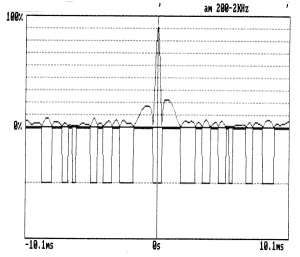
Typical cross correlation between drain noise and AM component.
Tunable Resonators and Low Loss Filters
J K A Everard
New design techniques have been applied to microwave bandpass filters to demonstrate compact low cost filters using transmission lines, helical resonators and capacitors. Stripline filter structures which demonstrate very low radiation loss have been developed as shown. These filters do not require screening boxes and have the inherent high Qs of the materials used. Unloaded Qs of 520 have been obtained at 5 GHz in unscreened filters and unloaded Qs of 80 have been achieved at 21GHz on microwave resonators. New resonators (both hybrid and MMIC) which can tune over a near octave frequency range have been developed for use in tunable microwave oscillators and filters. New high Q (235 at 2GHz) very compact resonators and filters base on printed helical resonators have been developed. These have been designed to ensure that the standing wave current is near zero through the via hole. Resistive loading has been used to suppress even order responses.
New design techniques have been applied to microwave bandpass filters to demonstrate compact low cost filters using transmission lines, helical resonators and capacitors. Stripline filter structures which demonstrate very low radiation loss have been developed as shown. These filters do not require screening boxes and have the inherent high Qs of the materials used. Unloaded Qs of 520 have been obtained at 5 GHz in unscreened filters and unloaded Qs of 80 have been achieved at 21GHz on microwave resonators. New resonators (both hybrid and MMIC) which can tune over a near octave frequency range have been developed for use in tunable microwave oscillators and filters. New high Q (235 at 2GHz) very compact resonators and filters base on printed helical resonators have been developed. These have been designed to ensure that the standing wave current is near zero through the via hole. Resistive loading has been used to suppress even order responses.
Ultra high Q resonators operating at room temperature are currently under investigation. Room temperature Qs of 24,000 and 60,000 are readily achieved with simple structures using BaTiO3 and Sapphire respectively. New structures with a 10 fold improvement in Q (at room temperature) are currently being modelled and investigated.
Supported by EPSRC

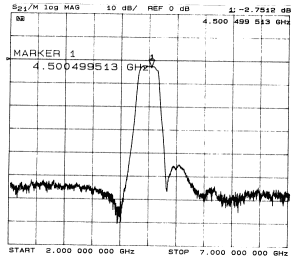
Broadband Power Efficient RF and Microwave Amplifiers
J K A Everard
Broadband power efficient Class E amplifiers have been developed for use from 120 to 180 MHz. New CAD techniques were developed to implement the rapid design and evaluation of such circuits. New circuits which present the optimum complex impedance to the active device over a broad frequency range have been developed. These design techniques are now being extended to produce hybrid, microstrip and MMIC versions operating above 900 MHz for use in mobile telephones and communications systems. Distributed load networks have been developed which produce efficiencies greater than 75% with 500 mW output power at 1 GHz. A 'real time' load network simulator has been written which allows full tuning of the component values and frequency while observing the waveforms at all the nodes in 'real time' on an oscilloscope like display.
Broadband power efficient Class E amplifiers have been developed for use from 120 to 180 MHz. New CAD techniques were developed to implement the rapid design and evaluation of such circuits. New circuits which present the optimum complex impedance to the active device over a broad frequency range have been developed. These design techniques are now being extended to produce hybrid, microstrip and MMIC versions operating above 900 MHz for use in mobile telephones and communications systems. Distributed load networks have been developed which produce efficiencies greater than 75% with 500 mW output power at 1 GHz. A 'real time' load network simulator has been written which allows full tuning of the component values and frequency while observing the waveforms at all the nodes in 'real time' on an oscilloscope like display.
Microwave Broadband Negative Group Delay Circuits
C Broomfield, J K A Everard
Microwave negative group delay circuits offering octave bandwidths have recently been produced - see Electronics letters November 2000, Vol. 36, No33.
Microwave negative group delay circuits offering octave bandwidths have recently been produced - see Electronics letters November 2000, Vol. 36, No33.
Dynamic Self Routing All Optical Switches
J K A Everard, M Page-Jones
All optical Switches have been developed which automatically route optical data signals where the data, destination address and optical power are all contained within the single optical laser beam. This is the optical equivalent of the old Strowger Exchange. A new all optical system with one input and three outputs has recently been demonstrated at the Royal Society using an input optical power of 300 micro-watts. This is believed to be the first all optical switch which contains the data, destination address and power all within the same 300 microwatt I/P laser beam. The switch operates by automatically producing a diffraction grating within an non linear crystal which rotates according to the destination address. The coding is carried within the autocorrelation of the input signal which in this case is the distance between adjacent pulses.
All optical Switches have been developed which automatically route optical data signals where the data, destination address and optical power are all contained within the single optical laser beam. This is the optical equivalent of the old Strowger Exchange. A new all optical system with one input and three outputs has recently been demonstrated at the Royal Society using an input optical power of 300 micro-watts. This is believed to be the first all optical switch which contains the data, destination address and power all within the same 300 microwatt I/P laser beam. The switch operates by automatically producing a diffraction grating within an non linear crystal which rotates according to the destination address. The coding is carried within the autocorrelation of the input signal which in this case is the distance between adjacent pulses.
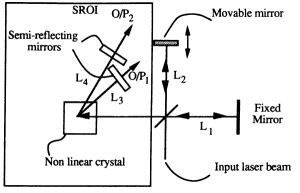 | All optical switching. |
Demonstration of switching between |
O/P 1 | and | O/P 2 |
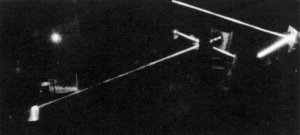 | 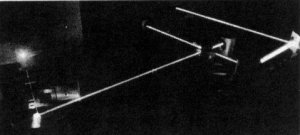 |
Picosecond Opto-Electronics
J K A Everard, N Ghogomu
Ultra-fast opto-electronic detectors and mixers have been developed with bandwidths extending from DC to 50 GHz (5 ps rise time). Most recently a 3-wave opto-electronic mixer has been demonstrated which detects two optical signals spaced 33 GHz apart. These signals are detected and downconverted to 500 MHz all within the same device. MMIC versions, as illustrated below, have been fabricated and shown to work. Analysis predicts performance often better than ideal photodiodes. These devices are being used for coherent detection and downconversion and as phase detectors for phase locking semiconductor lasers. Current devices demonstrate a sensistivity of -60dBm @ 33GHz in a 1MHz bandwidth with a S/N=1. Shot Noise limited subpicosecond devices are currently being investigated.
Ultra-fast opto-electronic detectors and mixers have been developed with bandwidths extending from DC to 50 GHz (5 ps rise time). Most recently a 3-wave opto-electronic mixer has been demonstrated which detects two optical signals spaced 33 GHz apart. These signals are detected and downconverted to 500 MHz all within the same device. MMIC versions, as illustrated below, have been fabricated and shown to work. Analysis predicts performance often better than ideal photodiodes. These devices are being used for coherent detection and downconversion and as phase detectors for phase locking semiconductor lasers. Current devices demonstrate a sensistivity of -60dBm @ 33GHz in a 1MHz bandwidth with a S/N=1. Shot Noise limited subpicosecond devices are currently being investigated.

Optical Fibre Spectrum Analysers
J K A. Everard, M Page-Jones
An optical fibre spectrum analyser has been built which uses a Michelson fibre interferometer to measure the autocorrelation function and hence the spectrum of optical signals. The autocorrelation function is obtained by using the stretching of polarisation maintaining fibre in a balanced configuration. Differential delays of 3 cms in a scan time of 50 ms have been achieved. Techniques for joining Andrews single mode elliptically cored fibre to D fibre with transmission greater than 80% have been developed. This allowed all fibre systems to be built. These systems can also be used for fibre sensors and for programming the all optical self-routing switches
An optical fibre spectrum analyser has been built which uses a Michelson fibre interferometer to measure the autocorrelation function and hence the spectrum of optical signals. The autocorrelation function is obtained by using the stretching of polarisation maintaining fibre in a balanced configuration. Differential delays of 3 cms in a scan time of 50 ms have been achieved. Techniques for joining Andrews single mode elliptically cored fibre to D fibre with transmission greater than 80% have been developed. This allowed all fibre systems to be built. These systems can also be used for fibre sensors and for programming the all optical self-routing switches
Supported by EPSRC
Optical Fibre Sensors
J K A Everard, N Ghogomi, R Thomas, M Page-Jones
Microwave radar techniques (Spread Spectrum Raman OTDR) have been used to develop a distributed optical fibre temperature sensor capable of measuring the temperature distribution over a Kilometre of fibre with degree sensitivity and metre spatial resolution as shown below. Coherent Brillouin temperature sensors have been demonstrated and are under further investigation. New sensors with sub meter resolution are being developed.
Microwave radar techniques (Spread Spectrum Raman OTDR) have been used to develop a distributed optical fibre temperature sensor capable of measuring the temperature distribution over a Kilometre of fibre with degree sensitivity and metre spatial resolution as shown below. Coherent Brillouin temperature sensors have been demonstrated and are under further investigation. New sensors with sub meter resolution are being developed.
Supported by EPSRC and University of York

MMIC Implementations of Opto-Electronic and Microwave Circuits
J K A Everard
Oscillators, tunable resonators, filters, high efficiency amplifiers and photoconductive three wave optical mixers and detectors have been built on hybrid and monolithic microwave integrated circuits (MMIC's). Currently complete radio transmitters (including the power efficient RF amplifier) and receivers are being designed on monolithic microwave integrated circuits and have already been built in hybrid form. A microwave Doppler Radar is shown below. Coherent optical receivers and downconverters incorporating the microwave oscillators are being designed.
Oscillators, tunable resonators, filters, high efficiency amplifiers and photoconductive three wave optical mixers and detectors have been built on hybrid and monolithic microwave integrated circuits (MMIC's). Currently complete radio transmitters (including the power efficient RF amplifier) and receivers are being designed on monolithic microwave integrated circuits and have already been built in hybrid form. A microwave Doppler Radar is shown below. Coherent optical receivers and downconverters incorporating the microwave oscillators are being designed.
Supported by EPSRC
Neyker Stewart Zambrano
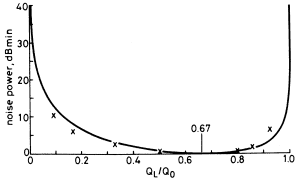

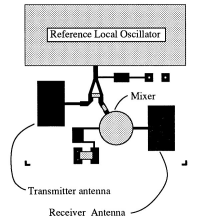
No hay comentarios:
Publicar un comentario